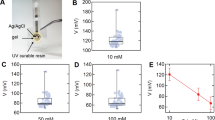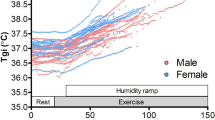Summary
Sweat rates and rectal temperatures were measured hourly in two sets of 4 hour experiments. In one set, the men worked at a constant rate of 1560 ft. lbs/min requiring an oxygen consumption of 1.0 litre/ min (i.e. a metabolic rate of 5 Cal/min), at four different levels of heat stress, i.e., 87, 90, 93 and 96°F Effective Temperature on different days. In the other, the environmental heat stress was kept constant at 90° F Effective Temperature and the subjects worked at four different levels of work, each on a different day. The sweat rate/rectal temperature relationships, both on an hourly basis and as an average of the 4 hours of exposure, were closely similar in these two experiments. From this fact it is concluded that the increase in core temperature is the main factor controlling the rate of sweating. The curves relating sweat rate to rectal temperature were a little higher in the experiment in which the work rate was increased, indicating that muscular exercise has a specific and small effect on the sweat rate, apart from its influence on the core temperature. The curves fitted to sweat rate against rectal temperature showed the characteristic “sensitive” zone, i.e., a rapid rise in sweat rate with increase in rectal temperature between 98.2 to 101.0 ° F and a zone of “saturation” of the control channel, i.e., sweat rate reached a maximum value when rectal temperature rose above 101.0 ° F.
A study was also made of the sweat rate/rectal temperature relationship in an experiment in which the work rate was increased at the end of each hour at a constant level of heat stress and in another experiment in which heat stress was increased at the end of each hour at a constant work rate.
The curves of sweat rate against rectal temperature drawn on data obtained from these two experiments were similar but they were different from those in the first two sets of experiments, presumably because of the sweat suppression effect in the third and fourth hours of exposure.
The advantages and disadvantages of the various experimental procedures are discussed.
Similar content being viewed by others
References
Fox, R. H., R. Goldsmith, I. F. G. Hampton, andH. E. Lewis: The nature of the increase in sweating capacity produced by acclimatization to heat. J. Physiol. (Lond.)171, 363–376 (1964).
Hertig, B. A., M. L. Riedesel, andH. S. Belding: Sweating in hot baths. J. appl. Physiol.16, 647–651 (1961).
Lind, A. R.: A physiological criterion for setting thermal environmental limits for everyday work. J. appl. Physiol.18, 51–56 (1963).
Minich, G. S.: An inexpensive hot room. J. appl. Physiol.15, 1154–1155 (1960).
Neilsen, M.: Die Regulation der Körpertemperatur bei Muskelarbeit. Skand. Arch. Physiol.79, 193–200 (1938).
Robinson, S.: Temperature regulation in exercise. Pediatrics32, 691–702 (1963).
van Beaumont, W., andR. W. Bullard: Sweating in rapid response to exercise. Science141, 643–646 (1963).
Wyndham, C. H., W. v. d. M. Bouwer, H. E. Patterson, andM. G. Devine: Practical aspects of recent physiological studies in Gold Mines. J. Chem. Met. Min. Soc. (S.A.)7, 287–313 (1953).
—,N. B. Strydom, J. F. Morrison, F. D. du Toit, andJ. G. Kraan: Responses of unacclimatized men under stress of work and heat. J. appl. Physiol.6, 681–686 (1954).
—: Role of skin and core temperatures in man's temperature regulation. J. appl. Physiol.20, 31–36 (1965).
—,N. B. Strydom, J. F. Morrison, C. G. Williams, G. A. G. Bredell, J. S. Maritz, andA. H. Munro: Criteria for physiological limits for work in heat. J. appl. Physiol.20, 37–45 (1965).
Author information
Authors and Affiliations
Rights and permissions
About this article
Cite this article
Wyndham, C.H., Williams, C.G., Morrison, J.F. et al. A comparison of multi-stress tests on the sweat rate/rectal temperature relationship. Int. Z. Angew. Physiol. Einschl. Arbeitsphysiol. 23, 305–321 (1967). https://doi.org/10.1007/BF00698040
Received:
Issue Date:
DOI: https://doi.org/10.1007/BF00698040




